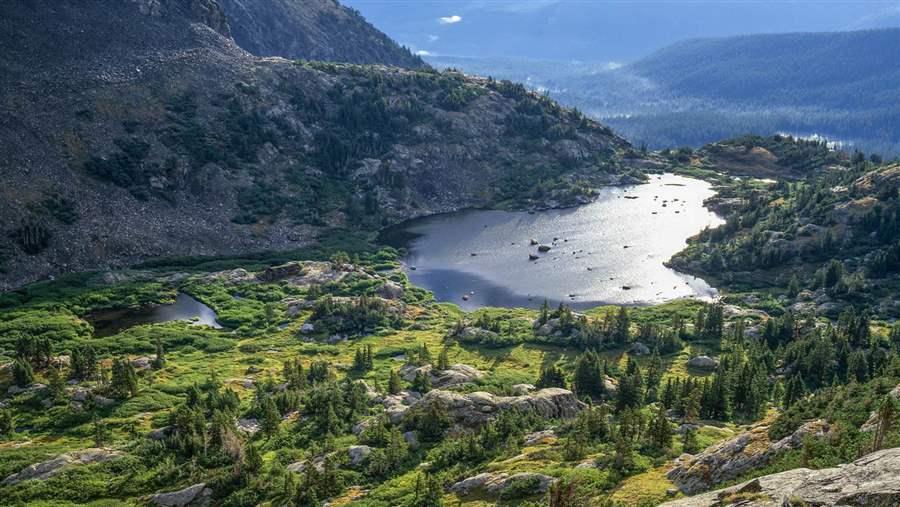U.S. Needs Wilderness Now More Than Ever

42,000 acres in Colorado are home to bighorn sheep, black bears, lynxes, and other wildlife.
John FielderWhen was the last time you stopped in your tracks and, even after turning in every direction, neither saw nor heard evidence of humankind? If it’s been a while, you might be overdue for a visit to a wilderness area.
No, not your local woodland, river, beach, or even the nearest national park. While all those are special, the 765 designated wilderness areas in the U.S. that comprise the National Wilderness Preservation System are the country’s only places protected by the highest standard of conservation, where natural values are paramount and motors and mechanized vehicles—even bicycles—are prohibited.
September is National Wilderness Month, and Congress is considering more than 20 wilderness-related bills, so now is a good time to reflect on the origins of U.S. wilderness protections and why the country needs these places more than ever.
The 1964 Wilderness Act defines wilderness as areas “affected primarily by the forces of nature, with the imprint of man's work substantially unnoticeable.” These are places “where the earth and its community of life are untrammeled by man, where man himself is a visitor who does not remain,” and that offer “outstanding opportunities for solitude or a primitive and unconfined type of recreation.”
From the Gates of the Arctic in Alaska to the Florida Keys Wilderness, and from Maine’s Caribou-Speckled Mountain to California’s Otay Mountain, designated wilderness sites afford people from all walks of life the opportunity to stand in awe of nature’s finest work, breathe clean air, and linger in the sound of silence.
Perhaps the authors of the Wilderness Act foresaw how the United States would look in the 21st century: a burgeoning population, the proliferation of vehicles for outdoor recreation, and escalating conflicts over whether to convert public land to private holdings for development.
Such pressures demand a rigorous approach to safeguarding wilderness, especially if lawmakers hope to give visitors access to the “solitude” and “unconfined recreation” promised in the Wilderness Act. We go to the wilderness to escape the modern, mechanized world—noise pollution, exhaust fumes, and even the clicking of mountain bike gears.
That’s why softening the rules governing wilderness areas, as some lawmakers have proposed, would defy the spirit of U.S public land protection and lead, almost inevitably, down a slippery slope. For once lawmakers allow one new activity in designated wilderness, the enthusiasts for other pursuits will line up and demand their access too.
Besides, options abound for those seeking public lands open to mountain biking, snowmobiling, all-terrain vehicle riding, waterskiing, and more. In fact, wilderness now makes up only 5 percent of U.S. lands, and even if all newly proposed wilderness sites were to gain congressional approval, that figure would only inch up a single percent.
Those areas under congressional consideration for new or expanded wilderness status include 245,500 acres in California’s Los Padres National Forest and Carrizo Plain National Monument, which would ensure the ecological future of 26 protected species; 42,000 acres in Colorado’s White River National Forest that are home to bighorn sheep, black bears, lynxes, and other wildlife; and 107,800 acres in Oregon, some surrounding the Rogue River, renowned for its pulsing whitewater and densely forested canyon scenery. Other proposed wilderness areas include 21,500 acres within New Mexico’s Río Grande del Norte National Monument, along one of the world’s great avian migratory routes, and 20,000 acres of Tennessee’s Cherokee National Forest, in an area the U.S. Forest Service describes as harboring “everywhere-you-look beauty.”
And there are more, all deserving of protection. Instead of entertaining ideas to relax the standards of wilderness areas, Congress should move to approve these new wilderness designations to give Americans more opportunity to experience a small piece of the Earth largely unmarked by the hand of humankind.
Mike Matz is a director of the U.S. public lands program at The Pew Charitable Trusts, where he leads wilderness and national monument projects.
This article originally appeared at thehill.com.







